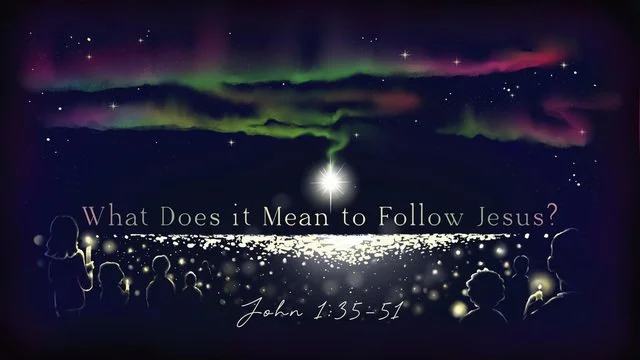Series: Signs & Glory
Title: What does it mean to follow Jesus?
Scripture: John 1:35-51
Genesis 28:11-12; 2 Kings 6:14-17; Hebrews 1:14
Lean a tall ladder against the back wall on the stage. Or set it up as an A-frame closer to the front.
Bottom line: Following Jesus is humbling ourselves and apprenticing to lead people to Jesus as part of a supernatural way of life.
INTRODUCTION
CONTEXT
SERMON OUTLINE
CONCLUSION
NOTES
OUTLINES
QUESTIONS TO CONSIDER
DISCUSSION QUESTIONS
MAIN REFERENCES USED
My opening prayer: Lord God, help us grow to be and do like Jesus, while abiding in him and leading others to do the same.
INTRODUCTION
Welcome 2025! Apparently, I'll be learning more new things in 2025. We've been homeowners for at least 25 years and I learned something new about owning a home this weekend. We had our house re-roofed recently and I learned that when that happens, a lot of debris rains down onto the things you have stored in the attic! So I learned something new!
We talk a lot about following Jesus here at Grace. And it's tempting to think that once you hear a sermon or two on that you're good to move on. But the Bible revisits it quite a lot. And since we're preaching through the Bible, we will repeat that a lot too.
But here's the thing: Every topic you could choose to hear a sermon on relies heavily on understanding what it means to follow Jesus. Well John is going to go there with us today. Both John's, in fact. So here we go!
CONTEXT
This series is called Signs & Glory. Zooming out, this book of the Bible by John the Apostle or Disciple is written that we might believe that Jesus is the Messiah and the Son of God and that by believing have life in his name. That's the point of this gospel account of the life, death and resurrection of Jesus the Christ.
Zooming in further, we see this gospel account divided into 2 major sections.
The first 12 chapters will show us the 7 signs of belief along with many others truths that illustrate and justify the teachings of Jesus.
Chapters 13-20 will show us the glory of God on full display. We'll see the light, life and love of God through his divine AND human son, Jesus of Nazareth during the last week of his life.
In John 1:19-2:12, the apostle John begins his gospel narrative like the synoptic gospels (Matthew, Mark & Luke) do: Beginning with John the Baptist. This chunk of scripture covers Jesus' first week of public ministry. It skips his actual baptism, though he implies it. It also skips his 40 days being tempted by Satan in the wilderness. John assumes his readers already know about this and, even if they don't, it's well covered in the synoptic gospels already. He's moving on so he can focus on the themes he feels led to focus on.
6 of the 7 days are mentioned so we'll point those out along the way. Verse 19 is day 1 of his first week.
The first 12 chapters of John are about the Signs of the Messiah. After that, John's focus is on the Glory of the Messiah.
SERMON
What does following Jesus mean/look like?
Learning/apprenticing (Disciple)
Information vs
Transformation
Going (Evangelist-->Apostle)
Most of disciples were brought to Jesus by a disciple of Jesus
Start with those closest to you
Leading Others #LOTDTS
Jesus modeled this from the beginning
This isn't about gifting--this is about obedience
Living/experiencing Supernatural life
Story 1
Story 2
Lord's Supper tie-in
CONCLUSION
"ON A DARK NIGHT about a hundred years ago a Scottish missionary couple found themselves surrounded by cannibals intent on taking their lives. On that terror-filled night the couple fell to their knees and prayed that God would protect them. It was a horrible time. Intermittent with their prayers, the missionaries heard the cries of the savages and imagined them coming through the door to take their lives. As the sun began to rise, to their astonishment they found that the natives were retreating into the forest. The missionaries were absolutely amazed and filled with joy. Their hearts soared to God. It was a day of rejoicing!
The couple bravely continued their work. A year later the chieftain of that tribe was saved. As the missionary spoke with him, he remembered the horror of that night and asked the chieftain why he and his men had not killed them.
The chieftain replied in surprise, "Who were all those men who were with you?" The missionary answered, "There were no men with us. It was just my wife and myself." The chieftain began to argue with him, saying, "There were hundreds of tall men in shining garments with drawn swords circling about your house, so we could not attack you."
That story, recorded in Billy Graham's book Angels, is one of the greatest stories in missionary history. The missionary was the almost legendary John G. Paton of the New Hebrides. What a glorious story for the church — a story not often repeated or experienced, yet one that does have contemporary parallels."
"Another vivid story was shared with me by a respectable Southern California pastor's wife. One evening she was driving down the Santa Ana Freeway, which is always busy. As she drove down that freeway, somehow the car door opened, and her four-year-old child tumbled out onto the freeway amidst the high-speed traffic. With her heart pounding and with horrible expectations, she pulled her car to a screeching stop and ran frantically back along the freeway. But she did not expect to see what she saw. Her child was sitting up in the fast lane of the freeway amidst the glare of headlights, his only injuries a few abrasions.
The first words that came out of his mouth were, "Mommy, Mommy, I saw Jesus put up his hands and stop the cars!" Was that a child's imagination? Possibly. None of the drivers saw anyone. They just managed to stop their cars and miss him. The boy had been raised in a pious home, so perhaps he was just parroting what he had heard others say. On the other hand, it may indeed have been angelic intervention, considering the incredible danger in that unusual situation."
Both from Kent Hughes commentary, pp. 51-52
Bottom line: Following Jesus is humbling ourselves and apprenticing to lead people to Jesus as part of a supernatural way of life.
What about you?
Peter puts it all in perspective in his first sermon:
““Therefore let all Israel be assured of this: God has made this Jesus, whom you crucified, both Lord and Messiah.” When the people heard this, they were cut to the heart and said to Peter and the other apostles, “Brothers, what shall we do?” Peter replied, “Repent and be baptized, every one of you, in the name of Jesus Christ for the forgiveness of your sins. And you will receive the gift of the Holy Spirit. The promise is for you and your children and for all who are far off—for all whom the Lord our God will call.”” Acts 2:36-39 NIV
Invitation
How do we respond? Answer 2 questions:
Take out a card or piece of paper right now. Write down the answer to these questions:
What is God saying to me right now?
What am I going to do about it? Write this down on a sheet of paper.
What I hear you saying, Lord, is ___________________.
[my name] is going to believe/do __________________________________________________ as a result.
Finally, share this with your Home or Mission group this week when you gather as a testimony about what God is doing in your life. You don’t have to get too specific to give him praise.
Lord's Supper, 1 Cor 11:23-26 is good passage.
Also, say something like, "Christ has died, Christ is risen, Christ will come again." (past, present, and future)
Pray
NOTES
OUTLINES
Outline from Willmington's Outline Bible
OUTLINE JOHN 1
John begins his Gospel by talking about the deity of Christ, then describes the ministry of John the Baptist. Jesus is baptized and calls his first disciples.
I. FACTS CONCERNING THE PREINCARNATE CHRIST (1:1-5)
A. His relationship to the Father (1:1-2)
1. Christ's eternality is declared (1:1a, 2): He already existed in the beginning.
2. Christ's deity is declared (1:b): He is God.
B. His relationship to the world (1:3-5)
1. He is the sole creator (1:3): Nothing exists that he didn't make.
2. He is light and life (1:4-5): His life gives light to everyone, and the darkness cannot extinguish it.
II. FACTS CONCERNING THE INCARNATE CHRIST (1:6-51)
A. The miracle (1:14): God became human and lived on earth among us.
B. The mission (1:10-13): He came to save sinners.
1. Some rejected him (1:10-11): The world and even the people in his own country did not understand him.
2. Some received him (1:12-13): Those who believed him became children of God.
C. The men (1:6-9, 15-51)
1. Christ's faithful forerunner (1:6-9, 15-34)
a. John the Baptist and the crowds (1:6-9, 15-18): John makes three key statements to the people.
(1) He is to serve as a witness to Christ (1:6-9).
(2) Christ is greater than John or Moses (1:15-17).
b. John the Baptist and the critics (1:19-28): John speaks to the Pharisees who are sent to cross-examine him.
(1) John says that he is not the Messiah (1:19-20).
(2) John says that he is not Elijah (1:21).
(3) John says that he has been sent to prepare the way for the Lord (1:22-28).
c. John the Baptist and the Christ (1:29-34)
(1) He introduces the Savior (1:29-31).
(2) He baptizes the Savior (1:32-34).
2. Christ's first five followers (1:35-51)
a. Andrew and John the apostle (1:35-39)
b. Peter (1:40-42)
c. Philip (1:43)
d. Nathanael (1:44-51)
QUESTIONS TO CONSIDER
What do I want them to know?
Why do I want them to know it?
What do I want them to do?
Why do I want them to do it?
How do they do this?
DISCUSSION QUESTIONS
Discovery Bible Study process: https://www.dbsguide.org/
Read the passage together.
Retell the story in your own words.
Discovery the story
What does this story tell me about God?
What does this story tell me about people?
If this is really true, what should I do?
What is God saying to you right now? (Write this down)
What are you going to do about it? (Write this down)
Who am I going to tell about this?
Find our sermons, podcasts, discussion questions and notes at https://www.gracetoday.net/podcast
Alternate Discussion Questions (by Jeff Vanderstelt): Based on this passage:
Who is God?
What has he done/is he doing/is he going to do?
Who am I? (In light of 1 & 2)
What do I do? (In light of who I am)
How do I do it?
Final Questions (Write this down)
What is God saying to you right now?
What are you going to do about it?
MAIN REFERENCES USED
“John,” by R. Kent Hughes, Preaching the Word Commentary, Edited by Kent Hughes
Exalting Jesus in John, by Matt Carter & Josh Wredberg
“Look at the Book” by John Piper (LATB)
“The Bible Knowledge Commentary” by Walvoord, Zuck (BKC)
“The Bible Exposition Commentary” by Warren Wiersbe (BEC)
Outline Bible, D Willmington (OB)
Willmington’s Bible Handbook, D Willmington (WBH)
NIV Study Bible (NIVSB) https://www.biblica.com/resources/scholar-notes/niv-study-bible/
Chronological Life Application Study Bible (NLT)
ESV Study Bible (ESVSB) https://www.esv.org
The Bible Project https://bibleproject.com
“The Bible in One Year 2023 with Nicky Gumbel” bible reading plan on YouVersion app (BIOY)
ChatGPT 3.5
Read More




